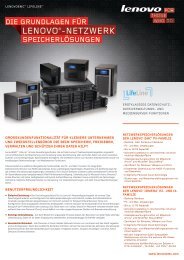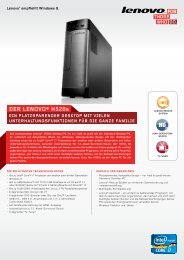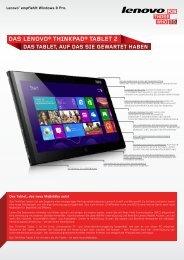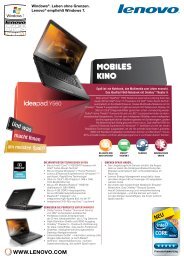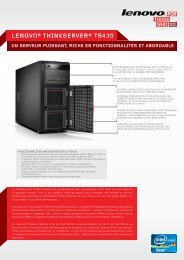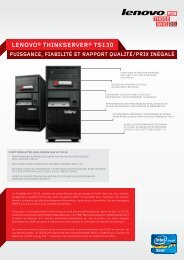Create successful ePaper yourself
Turn your PDF publications into a flip-book with our unique Google optimized e-Paper software.
2. Click Performance and Maintenance; then click System.<br />
3. Click the Hardware tab; then click Device Manager.<br />
4. Double-click Bluetooth Radios to extract the Bluetooth Radios device tree.<br />
5. Double-click the ThinkPad Bluetooth with Enhanced Data Rate icon to open the Properties window.<br />
6. Click the Driver tab; then click Update Driver.<br />
7. Click No, not this time, and then click Next.<br />
8. Select Install from a list or specific location (Advanced), and then click Next.<br />
9. Select Don't search. I will choose the driver to install; then click Next.<br />
10. Select the driver that has no “Digital Signed” icon; then click Next.<br />
11. Click Finish.<br />
Note: If you use the wireless feature (the 802.11 standard) of your computer simultaneously with a Bluetooth<br />
option, data transmission speed can be delayed and the performance of the wireless feature can be<br />
degraded.<br />
Using WiMAX<br />
Some ThinkPad notebooks come with a built-in wireless LAN card integrating WiMAX technology.<br />
WiMAX, a long-range wireless data transmission technology based on the 802.16 standard, provides you<br />
with a “last mile” broadband connectivity similar to that offered by cable or ADSL, but without the need to<br />
physically connect a cable to the PC.<br />
To use the WiMAX feature, start Access Connections.<br />
For Windows 7: To start the Access Connections wizard, see “Accessing applications in Windows 7” on<br />
page 33, and follow the instructions on the screen.<br />
For Windows Vista and Windows XP: To start the Access Connections wizard, click Start ➙ All Programs ➙<br />
ThinkVantage ➙ Access Connections. Then follow the instructions on the screen.<br />
Checking wireless connection status<br />
Access Connections Gauge (Windows 7)<br />
If your computer is running Windows 7, the Access Connections Gauge in the task bar displays the signal<br />
strength and status of your wireless connection.<br />
Note: To display Access Connections Gauge in the task bar, see the Help in Access Connections.<br />
You can find more detailed information about the signal strength and status of your wireless connection<br />
by opening Access Connections or by right-clicking the Access Connections Gauge in the task bar and<br />
selecting View Status of Wireless Connection.<br />
• Access Connections Gauge states: wireless LAN<br />
– Power to the wireless radio is off or no signal.<br />
– Power to the wireless radio is on. The signal strength of the wireless connection is poor. To<br />
improve signal strength, move your system closer to the wireless access point.<br />
– Power to the wireless radio is on. The signal strength of the wireless connection<br />
is marginal.<br />
68 <strong>User</strong> <strong>Guide</strong>







